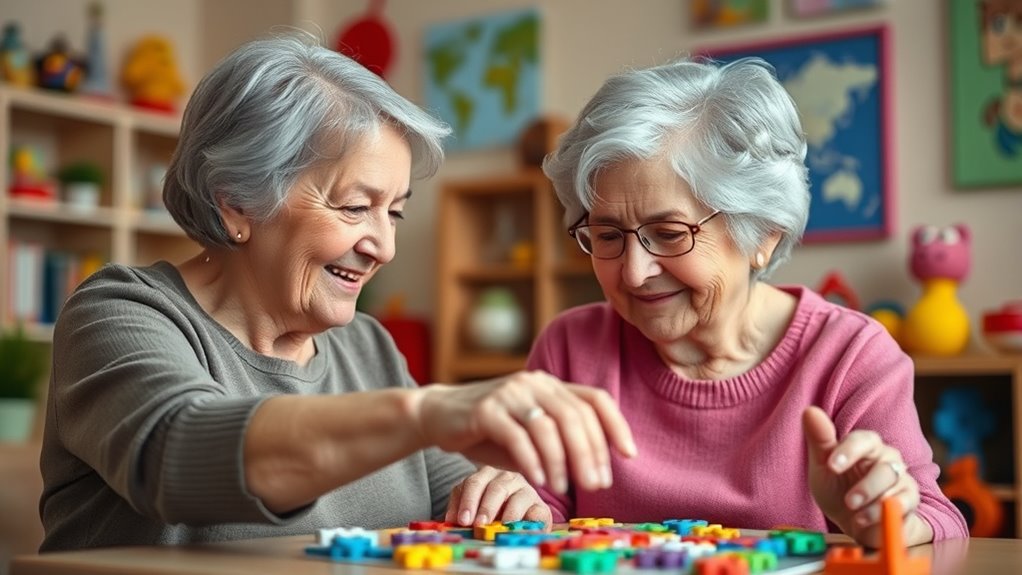To manage agitation in mid-stage Alzheimer’s, watch for early signs like restlessness or irritability, and respond calmly. Create a safe, clutter-free environment with consistent routines to reduce confusion. Avoid triggers such as loud noises or unfamiliar surroundings, and use distraction or redirection when agitation arises. Communicate gently and with patience, validating feelings to ease frustration. For more tips on handling these challenging moments effectively, exploring additional strategies can make a real difference in your loved one’s well-being.
Key Takeaways
- Recognize early signs of agitation and identify triggers to prevent escalation.
- Create a calm, safe environment with consistent routines and minimal sensory overload.
- Use compassionate communication, nonverbal cues, and validate feelings to reduce frustration.
- Implement environmental modifications and sensory management techniques, like decluttering and aromatherapy.
- Seek professional support and caregiver resources to develop tailored strategies and maintain caregiver well-being.
Recognizing Early Signs of Agitation

Recognizing the early signs of agitation in someone with Alzheimer’s can be challenging but is crucial for effective management. You might notice subtle changes in their behavior, such as increased restlessness, irritability, or pacing. They may become more withdrawn or express frustration through verbal outbursts or physical gestures. Changes in sleep patterns, such as waking frequently at night, can also signal rising agitation. Pay attention to their nonverbal cues, like clenched fists, facial grimacing, or tense posture, which often indicate discomfort or distress. Recognizing these early signs allows you to intervene promptly, helping to prevent escalation. Being attentive and aware of these subtle signals enables you to address underlying causes and provides a foundation for calming strategies that can improve their well-being. Monitoring behavioral patterns regularly can help identify triggers and prevent episodes before they escalate. Additionally, understanding Alzheimer’s progression helps caregivers anticipate and respond to potential triggers of agitation more proactively. Recognizing patterns related to the environment or routine can also help in identifying specific stressors that contribute to agitation episodes.
Creating a Calm and Safe Environment

To create a calm and safe environment, start by reducing noise and clutter that can overwhelm your loved one. Make sure walkways are clear and free of obstacles to support safe mobility. These simple adjustments can help prevent agitation and promote a sense of security. Incorporating safety features through gentle environmental modifications can further enhance comfort for those with Alzheimer’s.
Minimize Noise and Clutter
Creating a calm and safe environment begins with reducing noise and clutter, which can easily overwhelm someone with Alzheimer’s. Keep rooms quiet by turning off loud TVs, radios, or appliances when not in use. Avoid sudden loud sounds or frequent interruptions that can cause confusion or agitation. Clear clutter from walkways and surfaces to prevent trips and reduce visual distractions. Use simple, organized layouts so your loved one can find items easily without frustration. Maintain a consistent routine to help them feel secure. Soft lighting reduces glare and shadows that might cause confusion or fear. By creating a tidy, peaceful space, you help minimize overstimulation and promote a sense of calm, making daily life more manageable for someone with Alzheimer’s.
Ensure Safe Mobility
Ensuring safe mobility for someone with Alzheimer’s involves more than just removing obstacles; it requires actively designing the environment to prevent falls and confusion. You should install grab bars in bathrooms and along hallways, and use non-slip mats to reduce slipping risks. Keep pathways clear and well-lit, avoiding sudden changes in flooring or furniture placement that can cause disorientation. Consider installing door alarms or locks to prevent wandering, especially at night. Use contrasting colors or markings to highlight stairs or doorways, helping your loved one navigate safely. Regularly check for hazards like loose rugs or clutter. By creating a calm, organized environment, you reduce the chances of accidents and help your loved one maintain independence with confidence and safety.
Establishing Consistent Daily Routines
Establishing consistent daily routines provides a sense of stability and predictability for individuals with Alzheimer’s, which can markedly reduce their feelings of confusion and agitation. You can achieve this by sticking to regular times for waking, meals, activities, and bedtime. Consistency helps your loved one anticipate what comes next, minimizing uncertainty that triggers agitation. Keep routines simple and familiar, avoiding sudden changes that may cause distress. Use visual cues, like clocks or calendars, to reinforce daily patterns. Incorporate preferred activities and hobbies to foster comfort and engagement. Remember, patience is key—if routines need adjusting, do so gradually. Being mindful of signs of spoilage in food and drinks can help maintain a safe environment and prevent additional stress. Regular maintenance, such as checking for projector bulb wear, can also contribute to a well-organized and calming environment. Creating a calm environment by reducing noise and clutter can further help your loved one feel more secure and less prone to agitation. Additionally, incorporating elements of spiritual energy through calming rituals or familiar music can promote feelings of peace and stability. By establishing a predictable schedule, you create a calming environment, helping your loved one feel more secure and less prone to agitation.
Identifying and Avoiding Potential Triggers

To effectively manage agitation in individuals with Alzheimer’s, you need to recognize and prevent potential triggers before they cause distress. Start by observing what seems to upset or confuse them, such as loud noises, unfamiliar environments, or sudden changes in routine. Keep a diary to track patterns and identify specific triggers. Environmental factors like clutter, bright lights, or strong smells can also contribute to agitation. Pay attention to their physical needs—hunger, thirst, discomfort, or pain often cause frustration. Additionally, emotional triggers like feeling overwhelmed or anxious may lead to agitation. Once identified, minimize exposure to these triggers when possible. Preparing a calm, predictable environment and maintaining a gentle, reassuring approach can help prevent episodes before they start. Recognizing common triggers can help caregivers intervene early and reduce the frequency of agitation episodes.
Using Distraction and Redirection Techniques

When agitation begins to arise, distraction and redirection can be effective tools to shift your loved one’s focus away from distressing stimuli. Start by calmly introducing a different activity or topic that interests them, such as looking at photos, listening to music, or engaging in a simple task. Use a gentle tone and maintain patience, avoiding sudden movements or loud voices. If they’re upset about something specific, redirect their attention to a pleasant or neutral subject. Offering a comforting object, like a favorite blanket or stuffed animal, can also help. The goal is to interrupt the cycle of agitation without confrontation, calming their mind and body. Incorporating familiar items and vintage decor can evoke comforting memories and promote calmness. With practice, these techniques can reduce distress and promote a sense of safety and engagement.
Communicating Effectively With Your Loved One

After successfully redirecting your loved one’s attention to a calmer activity, clear and gentle communication becomes even more important. Speak slowly and calmly, using simple words and short sentences. Maintain eye contact and use a warm tone to help your loved one feel safe and understood. Avoid arguing or correcting their misunderstandings, as this can increase agitation. Instead, listen patiently and validate their feelings, saying things like, “I see you’re upset,” to acknowledge their emotions. Nonverbal cues, such as gentle touch or a reassuring smile, can also provide comfort. Remember, your tone and body language matter just as much as your words. Consistent, compassionate communication helps create a sense of security and reduces confusion. Understanding optimal angles for pinball machines can be a helpful analogy for adjusting your communication style to better suit your loved one’s needs. Paying attention to essential oils for calming anxiety can also support a more relaxed environment during interactions. Creating a calm and predictable environment at home can significantly reduce feelings of agitation and help your loved one feel more secure. Incorporating mindful decluttering strategies can further help reduce sensory overload and create a peaceful space. Being mindful of nonverbal cues can further enhance your ability to connect and reassure your loved one during challenging moments.
Seeking Support and Professional Guidance

Seeking support and professional guidance can make a significant difference in managing agitation in Alzheimer’s. When you reach out to healthcare professionals, you gain access to tailored strategies that address your loved one’s specific needs. Support groups connect you with others facing similar challenges, providing emotional comfort and practical advice. Professionals can evaluate potential medical causes of agitation and recommend appropriate treatments or adjustments. They also offer training on behavioral techniques and communication methods to reduce distress. Additionally, understanding divorce implications can help caregivers manage stress and plan for future needs. Recognizing the importance of toilet maintenance and repairs can also be beneficial for caregivers managing home environments, ensuring that basic needs are met safely and efficiently. Staying informed about legal finality of divorceensures you are aware of your rights and obligations, which can alleviate stress during transitional times. Incorporating vibrational alignment techniques can further support emotional stability for both caregivers and loved ones. Engaging with specialized caregiving resources can provide additional tools and knowledge tailored specifically to Alzheimer’s care challenges. Remember, you don’t have to handle everything alone. Seeking guidance assures you’re implementing the most effective approaches, helping your loved one feel calmer and more secure. Taking these steps not only benefits your loved one but also supports your well-being.
Frequently Asked Questions
How Can I Prevent Agitation From Worsening Over Time?
You can prevent agitation from worsening by creating a calm, predictable environment and sticking to routines. Pay attention to triggers like loud noises or uncomfortable clothing, and try to minimize them. Keep communication simple and reassuring, and offer comfort when needed. Regular activity and engaging in favorite activities can help reduce anxiety. Staying patient and calm yourself encourages your loved one to feel safe, which helps manage their agitation over time.

What Are the Best Ways to Handle Aggressive Behaviors?
Think of handling aggressive behaviors like calming a storm—you need patience and understanding. When your loved one acts out, stay calm, speak softly, and avoid arguing. Redirect their attention to a favorite activity or comfort item. For example, I once helped a resident who became aggressive by gently guiding them to a comfortable chair and playing their favorite music. Using gentle, consistent strategies helps de-escalate agitation and fosters trust.
How Do Medication Options Influence Agitation Management?
Medication options can substantially influence how you manage agitation. They may reduce symptoms, helping your loved one feel calmer and more comfortable. However, you need to work closely with healthcare providers to find the right medication and dosage, as each person reacts differently. Keep in mind that medications are just one part of a broader approach, including behavioral strategies and environmental adjustments, to effectively handle agitation.
Are There Specific Activities That Reduce Agitation in Mid-Stage Alzheimer’S?
You can help reduce agitation by engaging your loved one in calming activities like listening to soothing music, gentle exercise, or simple, familiar routines. Using familiar objects or photos can also provide comfort. Creating a calm environment, maintaining a consistent daily schedule, and avoiding overstimulation are effective strategies. These activities help soothe their mind and reduce feelings of frustration or confusion that often lead to agitation.
How Can I Support My Loved One’s Emotional Well-Being During Agitation Episodes?
Imagine witnessing your loved one caught in a storm of emotions, feeling helpless yet determined to bring calm. During agitation episodes, you can support their emotional well-being by staying calm yourself, offering gentle reassurance, and listening without judgment. Use soothing words, maintain a quiet environment, and avoid confrontation. Your presence, patience, and understanding create a safe space, helping them feel secure even amidst the chaos.
Conclusion
Think of managing agitation as tending a delicate garden. With gentle care, you remove weeds of triggers, nurture calm with routines, and guide your loved one’s growth with patience. Each moment is like watering a fragile sprout, helping it flourish despite the storms. Your steady hands and understanding are the sunlight that brings peace. By tending this garden daily, you help your loved one find serenity amidst the chaos, creating a peaceful sanctuary together.








